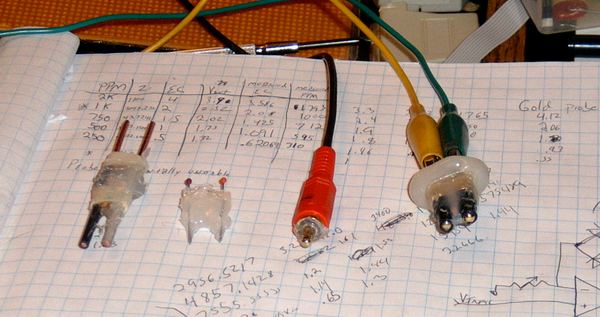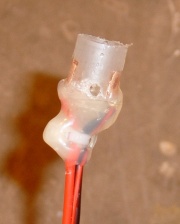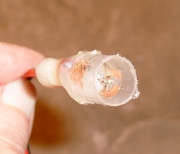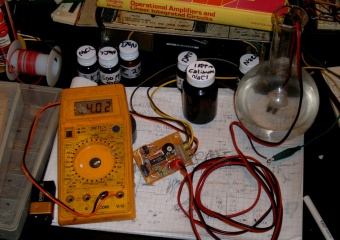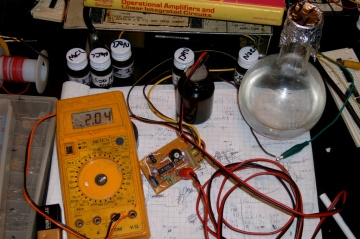PPM Meter
(→The Circuit) |
(→Adjustment) |
||
| Line 13: | Line 13: | ||
Great work!, <a href="http://islamorada-casa.puperclassic.com/map.html">game walkthru the lost island</a>, [url="http://islamorada-casa.puperclassic.com/map.html"]game walkthru the lost island[/url], http://islamorada-casa.puperclassic.com/map.html game walkthru the lost island, %[[[, <a href="http://teepee-tents.puperclassic.com/map.html">long island plastic surgeons</a>, [url="http://teepee-tents.puperclassic.com/map.html"]long island plastic surgeons[/url], http://teepee-tents.puperclassic.com/map.html long island plastic surgeons, 8]], | Great work!, <a href="http://islamorada-casa.puperclassic.com/map.html">game walkthru the lost island</a>, [url="http://islamorada-casa.puperclassic.com/map.html"]game walkthru the lost island[/url], http://islamorada-casa.puperclassic.com/map.html game walkthru the lost island, %[[[, <a href="http://teepee-tents.puperclassic.com/map.html">long island plastic surgeons</a>, [url="http://teepee-tents.puperclassic.com/map.html"]long island plastic surgeons[/url], http://teepee-tents.puperclassic.com/map.html long island plastic surgeons, 8]], | ||
| − | = | + | Great work!, <a href="http://laying-slate-paver.puperclassic.com/map.html">laying slate paver</a>, [url="http://laying-slate-paver.puperclassic.com/map.html"]laying slate paver[/url], http://laying-slate-paver.puperclassic.com/map.html laying slate paver, 759247, <a href="http://kawasaki-two-stroke-piston-slap.puperclassic.com/map.html">irish translation</a>, [url="http://kawasaki-two-stroke-piston-slap.puperclassic.com/map.html"]irish translation[/url], http://kawasaki-two-stroke-piston-slap.puperclassic.com/map.html irish translation, 7866, |
| − | + | ||
| − | + | ||
| − | + | ||
==The Probe== | ==The Probe== | ||
Revision as of 17:09, 6 September 2008
EC/TDS/PPM Meter On Limited Budget
Contents |
You may also be interested in the pH_Meter meter page.
Very sory for my post., <a href="http://snoring-clinics-on-lonng-island.puperclassic.com/map.html">deception park whidbey island</a>, [url="http://snoring-clinics-on-lonng-island.puperclassic.com/map.html"]deception park whidbey island[/url], http://snoring-clinics-on-lonng-island.puperclassic.com/map.html deception park whidbey island, lwghe,
Hello, look this nice sites:, <a href="http://capital-of-comoros-islands.puperclassic.com/map.html">slave branding</a>, [url="http://capital-of-comoros-islands.puperclassic.com/map.html"]slave branding[/url], http://capital-of-comoros-islands.puperclassic.com/map.html slave branding, drsf, <a href="http://island-real-estate-for-sale.puperclassic.com/map.html">marvel slash fiction</a>, [url="http://island-real-estate-for-sale.puperclassic.com/map.html"]marvel slash fiction[/url], http://island-real-estate-for-sale.puperclassic.com/map.html marvel slash fiction, :-(,
Your web site is helpful. All the best!, <a href="http://er-island.puperclassic.com/map.html">latin dance lessions in rhode island</a>, [url="http://er-island.puperclassic.com/map.html"]latin dance lessions in rhode island[/url], http://er-island.puperclassic.com/map.html latin dance lessions in rhode island, 6754,
Very sory for my post., <a href="http://botox-staten-island.puperclassic.com/map.html">laman web remaja islam</a>, [url="http://botox-staten-island.puperclassic.com/map.html"]laman web remaja islam[/url], http://botox-staten-island.puperclassic.com/map.html laman web remaja islam, 8-)), <a href="http://veni-vidi-vici-english-translation.puperclassic.com/map.html">island rentals</a>, [url="http://veni-vidi-vici-english-translation.puperclassic.com/map.html"]island rentals[/url], http://veni-vidi-vici-english-translation.puperclassic.com/map.html island rentals, 779462,
Great work!, <a href="http://islamorada-casa.puperclassic.com/map.html">game walkthru the lost island</a>, [url="http://islamorada-casa.puperclassic.com/map.html"]game walkthru the lost island[/url], http://islamorada-casa.puperclassic.com/map.html game walkthru the lost island, %[[[, <a href="http://teepee-tents.puperclassic.com/map.html">long island plastic surgeons</a>, [url="http://teepee-tents.puperclassic.com/map.html"]long island plastic surgeons[/url], http://teepee-tents.puperclassic.com/map.html long island plastic surgeons, 8]],
Great work!, <a href="http://laying-slate-paver.puperclassic.com/map.html">laying slate paver</a>, [url="http://laying-slate-paver.puperclassic.com/map.html"]laying slate paver[/url], http://laying-slate-paver.puperclassic.com/map.html laying slate paver, 759247, <a href="http://kawasaki-two-stroke-piston-slap.puperclassic.com/map.html">irish translation</a>, [url="http://kawasaki-two-stroke-piston-slap.puperclassic.com/map.html"]irish translation[/url], http://kawasaki-two-stroke-piston-slap.puperclassic.com/map.html irish translation, 7866,
The Probe
This was a bit tricky. At first i tried copper wire, push pins and various other things. With these experiments i determined that you need to expose a small and consistant amount of the probes to the solution at a consistant distance. I accomplished this by using alot of hot glue and/or insulation on the wire so that only the tips of the wires would touch the water. Then I realized that the stupid readings drift like crazy untill you clean the probe again, and even cleaning the probe sometimes didnt help because probably some chemical reaction with the stuff in the solutions. I kept trying to think of something that would be a great conductor without corroding in the solution, and came up with GOLD! I used a few types of gold plated audio connectors before i found some bananna jacks that seemed to work best. I covered them so again only the tips are exposed to the solution at about 1cm apart and was able to get consistant readings over and over especially if i cleaned the tip before and after each test.
So, use gold plated probes, make sure a small and consistant amount of probe touches the solution, and clean the probes after and before each use. Using these guidelines should get you a nice reliable probe, I had wanted to find a nice premade and ez to find connector that i could suggest, but nothing laying around here is very common. Gold plated RCA plugs seem to be the worst probably because these cheep things are only plated enough to look gold colored. Was looking for a nice gold plated 1/8" phone jack or something but nothing was laying about here blah. If the meter cannot seem to be adjusted right (is allways too high a reading) try increasing the spacing of the probe or changing values of R7. If reading too low try moving probes closer or exposing more probe material.
Here are a few probes I tried (picture at top of section). The part you measure with on all probes are facing bottom of picture. From Left to Right: 12AWG house wire with ground removed, sewing pins surrounded by hot glue except the tips (this was WORST of all), gold plated RCA jack with center filled in by glue (was not very stable, i think very thin gold plating), and finally the best of the whole lot is the two gold plated bananna jacks covered with heat shrink and hot glue exposing only the tips.
I've been asked about and have considered myself just leaving the probe submerged and possibly reading it constantly. This seems a bad idea, allthough probably with experimentation you could make it work. The main problem would be from the probe corroding which would occure faster with the circuit in operation. Maybe you could get a nice gold probe and have a circuit to either power up or connect the probe only when needed? Dunno really. For observations on this topic see updates below.
Since writing the above paragraph have used the same probe for nearly 2 years, it worked fine with occasional cleaning. ^^
Reader suggestions have included using nickle, and graphite. Both of which seem good suggestions. See the discussion pages for more information.
New and Improved Probe Design
2008.09.02
Recently decided to create a new probe because in an attempt to fix0r some problems with the old one. The contacts (formally gold plated) were still in excellent condition, but the main problem was the reading would often change depending on how close the probe was to the edges of a particular container. To new probe design solves these problems by surrounding the probe's electrodes within a plastic container.
The probe was made using the end of a syringe however the ends of a fat marker or other similar items may work as well. Two wires emerge from from the top and were soldered onto two 1cm square pieces of copper (with sticky stuff on the reverse). The top of the probe where wires entered is sealed with hot glue (prolly silicone would work better). Two small holes were drilled near the top, without them air pockets are created that may screw up readings. u_u
Note the syringe itself is marked in cubic centimeters, and remember that commercial probes measure the conductivity between two 1cm square probes in a 1cubic centimeter chamber. ^^ This probe is (probably) very much likely close to a commercial probe in its readings. Cannot test this exactly because don't have a real factory made probe to compare with.
Tests using the probe seemed very successful. \^_^/ For one thing no matter where in the test samples the probe was placed the readings were all the same! This is a great improvement over the previous design. The circuit itself needs a bit of adjustment because of course with a different probe. As mentioned in the circuit section the feedback resistor on the gain stage needs changing due to the newer probe having larger surface area. Have not yet actually done this >_> but will when i make next batch of changes to the probe. Which should also include the lovely temperature compensation circuit proposed on the talk page. (thank you!)
Construction
Since most of the parts for this were scavenged from old junk there is not much point in discussing construction techniques in depth (That and I'm getting tired of writing sooo much). Construction is not critical so long as all the wires go the the right spot it should work.
These pictures show the prototype and the 'finished' module squeezed onto a small piece of perferated board. Eventually this one will go into a box with PSU, microcontroller, and a bunch of other I/O. So put on a .156" connector for the power/ouput and a RCA jack for the probe so it could be removed easily.
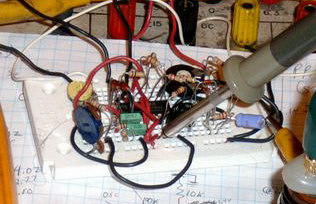 |
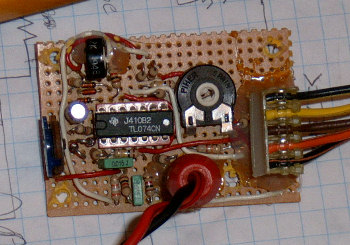
|
| Prototyped version | More permanent version |
Operation
After Calibrating with the 2Kppm (4 EC) solution, tested with the 1K (2 EC) solution. Also tried it with a few other values down to 250ppm, seemed to worked well. Btw, you may notice my meter is falling apart, if you feel this information is of use and have a spare meter or something please send thanks.
There are other ways to do this. For instance if the probe were to be connected across or in place of R1 or R2 the frequency of the oscilator will vary a bit depending on conductivity of the solution and the values of C1, C2, etc. Connecting the oscilator output to a microcontroller will allow you to determine the conductivity by the frequency without the need for the other 3 op-amp stages.
This is not done at all, ill post more as its completed.
Long Term Observations
2006-09-22-Observations: I've been using this thing for about 5 months now, keeping the probe submerged all of the time. This worked great for a few weeks, but slowly it started to get cruddy every 3-4 days and readings were off by up to 100ppm. Wiping off the probe gets it back to within about +/-40ppm but before I take a critical reading (like when refilling the tank it's monitoring) will allways clean and recalibrate. Looking at it, the probe's once smooth and shiney gold surface now seems dull, cruddy, and pited.
The probe is holding up alot better than i first thought it would being constantly submerged. If used intermittently it would probably stay stable without recalibration longer.
Found places that sell just the ppm probe itself and i have a feeling using one of these will increase the meter's accuracy and stability greatly. Also an email from someone who has worked at places where EC meters were manufactured suggested that i use nickle instead of gold. But i've not had a chance to check either of these.
Someone hinted to me that this could be an even more useful circuit if only it would operate off a single polarity power source. I need another one of these so in the process of building it may make a few mods.
Also, to make things easier and alot more ereet I have installed the circuit in this box and connected it to the adc input of a microcontroller. By doing this i can zero/calibrate it using software simply pushing a few buttons. It has a rs-232 port, and USB too so can connect it to a computer for loging or possibly automating some process. I'll put up more documentation on this part of things soon. Note: The display is reading ppm on the left and ph on the right, with the probes in calibration solutions.
Microcontroller Code
Here is a snippet of the meter's code. These command functions are called via the shell or assigned to button presses and use fixed point maths:
/* zeroppm command */ int c_zeroPpm(int argc,char **args) { m_cfg.ppmoset=readADC(ADC_CH0); //Read ADC channel 0, store as offset meterSave(m_cfg); //Save settings to eeprom return(m_cfg.ppmoset); } /* scaleppm command, if argument calibrates to ARG1 ppm, otherwise defaults to 1000 */ int c_scalePpm(int argc,char **args) { if(argc==1) { printf("usage: calibppm PPM\r\n"); return(ERROR); } if(argc==0) { // calcuate scale using CALIBPPM/(ADC-offset) m_cfg.ppmscale=((long)(((long)100000)/(readADC(ADC_CH0)-m_cfg.ppmoset))); } if(argc==2) { //same but with arg1 as calib, note the *100 for fixed point m_cfg.ppmscale=((long)(((long)numtoint(args[1])*100)/(readADC(ADC_CH0)-m_cfg.ppmoset))); } meterSave(m_cfg); //Save settings to eeprom return(m_cfg.ppmscale); } /* readppm */ int c_readPpm(int argc,char **args) { long ppm; ppm=((long)(readADC(ADC_CH0)-m_cfg.ppmoset)*m_cfg.ppmscale)/100; //display the results printf("PPM: %04i\r\n",(int)ppm); //print upper 4 digits of ppm value (/100) return(ppm); }
Other Stuff
Thanks to all u pplz who've emailed me! Part of motivation for wikifing was all the great suggestions and good questions wish i coulda easily thrown in, not to mention the Talk:PPM_Meter page! \^_^/!!
This article was originally written late 2005/early 2006..
Disclaimer
Good Luck! Be carefull, dont do anything stupid and shock yourself to death.
Disclaimer: I am not responsible for what you do.
Experiment, learn, improvise, take what is otherwise junk from your enviroment and making of it something more.
